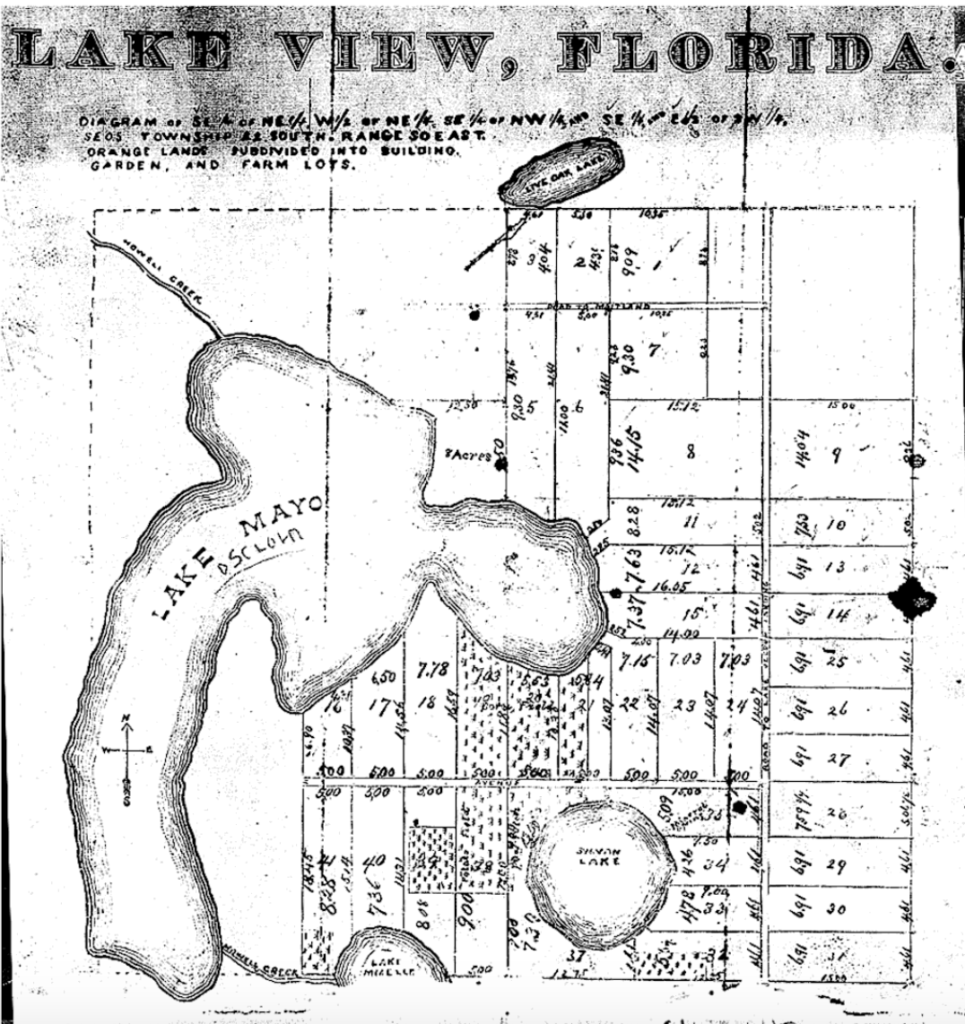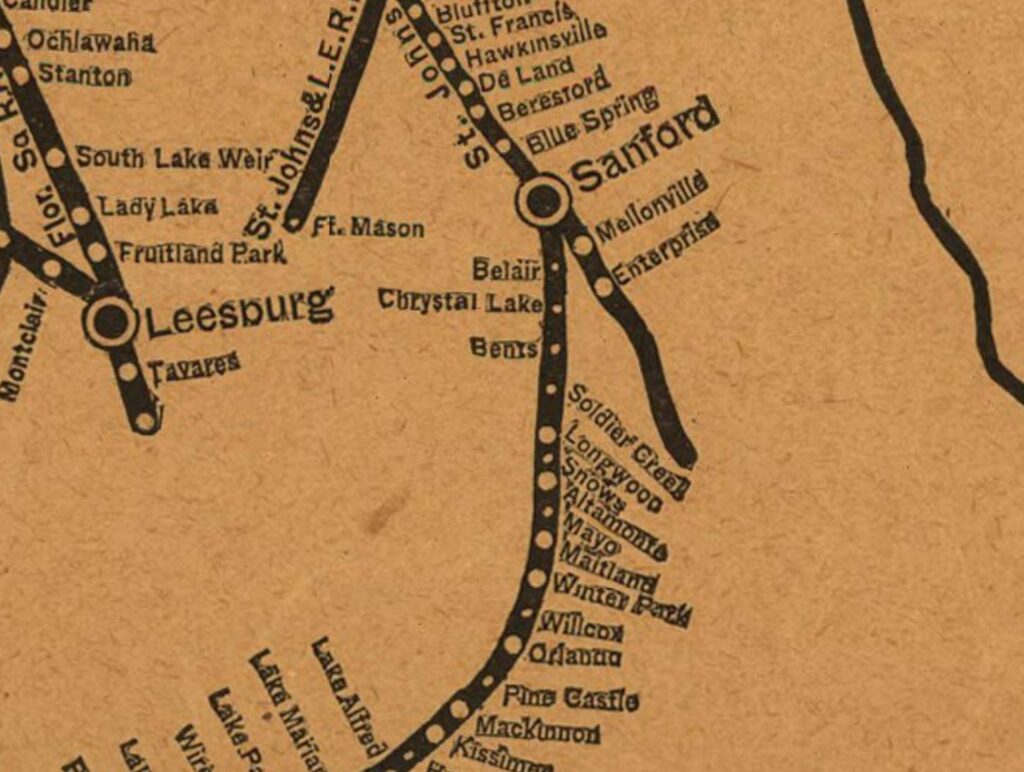Summary
Today all that exists to remind us that Mayo once existed is the tiny Mayo Avenue, a residential road that extends from 17-92 to Maitland Community Park. It was once a stop along the South Florida Railroad between Snows/Altamonte Springs and Maitland. The area is also tightly linked with the old town of Woodbridge, which was a black community just across the railroad tracks to the northwest.
Mayo was named for Colonel Rudolph G. Mayo, who came to the area in 1875. He had a large homestead in the area. Lake Osceola in Winter Park was once known as Lake Mayo.
Research Material
.
Plat of Lake View, Florida

Source: Winter Park, FL – A Historical Review Using Postcards
Orangeland
From the book: “Orangeland. A description of the topography, climate, soil, productions, resources, advantages, opportunities, prospects, and general characteristics of Orange County, Florida” Source: http://www.mapoftheweek.net/Post/688/orangelanddescri00adam.pdf
MAYO.
Four miles south of Longwood and fourteen from Sanford is Mayo Station, where are located several important industries, and about which in every direction are promising orange and lemon groves. The land is high and rolling pine, though just at the depot is a small patch of scrub which affords excellent and healthy building sites.
The first thing that attracts the attention is the large and well arranged saw and planing mill, with a capacity of 8,000 feet per day, owned and run by Messrs. Nevins & Prentis. About the mill yard are extensive piles of lumber ready for use.
To the west is Lake Seminary, a pretty sheet of water, on which Dr. Nevins has a little steamer and several row boats. East of the track are several small and not specially attractive cabins, but as the primitive period is past thev will doubtless soon give place to handsome and substantial buildings.
Just south of the saw mill is the ice factory of Dr. R. H. Nevins that has supplied this section and towns along the South Florida Railroad with ice for several years past- It originated from small beginnings, a little Pictet ice machine, with which the Dr. supplied his own household. Others wanted ice and the demand was so pressing that in 1880 he secured a machine with a daily capacity of 2,500 pounds.
The demand greatly exceeding the supply, in 1881 he increased the capacity to 5,000 pounds. This however did not keep pace with the development of the country and the past summer the Doctor has built an immense new building a little farther south and put in an entirely new ice machine with all the latest improvements that will make twelve tons (24,000 pounds) of ice daily. It is frozen in large oblong blocks and is very firm, clear and pure, better even and more lasting than lake ice. With so largely increased capacity he will doubtless be able to supply a large scope of country.
Opposite the new ice factory, east of the railroad, Mr. J. A, Prentis has built a fine two story packing house where many thousands of the oranges and lemons raised in this vicinity will doubtless be assorted, wrapped, packed, branded and shipped for market.
Just north of Mr. P’s place is a small country store. To the east are occasional indications of piney woods and black jack and other oaks, though much has been cleared and the place supplied with numerous orange groves.
Here, too, is the direct Maitland & Lake Jesup road, handsomely covered with saw dust. It runs directly through the homestead of
COL. RUDOLPH G. MAYO, the pioneer settler of the place. He was born in Saxony, and came in 1849 to Virginia. In January, 1875, he came to Florida, and looking over a part of the State invested on the Hillsborough River, a few miles south of New Smyrna.
Continuing his travels over a considerable part of the State, he settled on his present beautiful location, and commenced its improvement, it suiting him the best of any place he had seen. All about him were the piney woods interspersed with oak and a few unoccupied homesteaders’ cabins, the homestead laws being enforced very loosely at that time.
The part of his land to the east of Nevins & Prentis he has laid out into lots 100 x 300 feet and sold a number. A few acres in the southeast corner fronting on a beautiful lake with part of his grove, he has just sold to Mr. A. F. Ackerman, of Staunton, Va. Between this and his home lot is a tine bay covered with heavy growth and tilled with muck of so tine quality that it brings $3 a cord as a fertilizer.
The Col. has a very fine pine apple plantation of 13.500 plants, from which he derives a handsome income. On his residence lot are some 500 trees from three to ten years old, mostly budded. Besides these he has in grove 50 five years old trees, 200 three, 200 two, 6,000 nursery trees, three to two years old, and 30,000 one to two years old. The trees in grove are all budded and he has a number of the finest Mandarin orange trees we have seen, trees that bear remarkably large oranges, and one of very fine flavor ribbed fruit.
He also has camphor trees, other trees in great variety, very fine lemons, variegated orange and lemon trees, etc. His residence is on a handsome knoll overlooking a beautiful lake, with lovely shores and shady retreats. Around the house are a profusion of flowers and trailing vines. But the house itself is a beauty and unique, one of the very best contrived, finished and arranged in South Florida. To his congenial and accomplished lady is given the credit of its conception.
DR. R. H. NEVINS has a lovely home to the west of Lake Seminary and northeast of Lakes Faith, Hope and Charity, pleasant bodies of water about a mile long. He has one of the largest and finest houses in South Florida, two stories in height, with broad piazzas, wide halls, high ceilings and attractive finish. It affords magnificent views in every direction.
About the house are many flowers and the pillars and lattice work of the piazzas are covered with climbing jassamine and other vines. His line bearing grove, stables, etc., are a few rods to the northwest. He has 700 trees of varied ages in grove, and some 4,000 nursery trees.
The Doctor came here in 1879 from Waterford, Conn.
MR. J. A. PRENTIS, who came from New London, Conn., in November, 1881, has a fine thrifty grove of 1,400 trees, part bearing. Some are seedlings five to ten 3 years old, and some budded from one to four to 3 years. Whoever has occasion to deal with any of the gentlemen mentioned will find them courteous, agreeable and straightforward in every respect.
THE QUINNIPIAC FERTILIZER COMPANY, Of New London, Conn., is here represented by John A. Prentis. This Company have, the first year, put on the market the Fish Bone and Potash brand of their fertilizer, and the success attained has lead to the establishment at Mayo of a distributing warehouse for the further introduction of their goods.
MR. W. S. CHAPPELL, Of New London, is engaged in the packing business in connection with his business at the North, thus enabling the orange growers of this section to place their products without the trouble of packing, shipping and sending to markets which may be overstocked, and also saving all delay in returns. This is an enterprise which we have long required, and cannot fail of success.
1884 Southern Express Company Railroad Map
Source: Library of Congress (http://bit.ly/2PeddDh)
This map shows the stops along the line, including Mayo Station.

1980 Lawsuit for Land
In 1980 Southern States Realty Company filed suit against the unknown descendents of Rudolph Mayo and others. They still owned the land at that point. This newspaper article notifies these long dead people of the suit. It required them to file defense to protect their right to property on the north side of Lake Minnehaha in Maitland.
